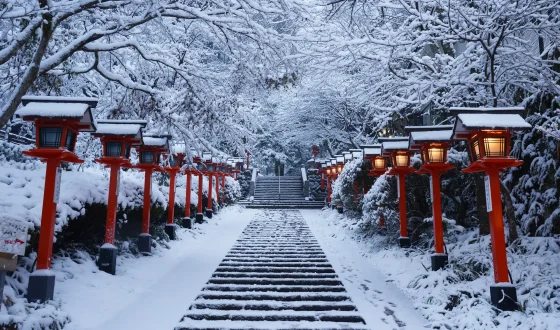Shabu Shabu and Hot Pot: Exploring the Differences and Delights of Asian Hot Pot Cuisine
Discover the ultimate showdown between Shabu Shabu and Hot Pot! Dive into a world of simmering broths, fresh ingredients, and communal cooking as we explore the delights of Shabu Shabu and Hot Pot.
Intro
Shabu Shabu and Hot Pot are both Asian dining styles that involve cooking a variety of ingredients in a communal pot at the table.
Shabu Shabu is a classic Japanese cuisine that includes thinly sliced beef or pork and a variety of vegetables including mushrooms, leafy greens, tofu, and noodles. The name “Shabu Shabu” refers to the swishing sound made when the ingredients are dipped into the simmering broth for just a few seconds, resulting in tender and flavorful bites. The cooked ingredients are then typically dipped in a savory sauce before eating.
Hot Pot, on the other hand, is a more general phrase for comparable dining experiences seen in numerous Asian nations such as China, Korea, and Thailand. A hot pot of boiling soup is put in the center of the table, along with a variety of foods like meat, fish, veggies, dumplings, and noodles. Each diner can customize their own personal bowl of soup by adding and cooking the ingredients of their choice in the communal pot. Various dipping sauces are often provided to enhance the flavors.
While both Shabu Shabu and Hot Pot share the concept of communal cooking and a focus on fresh ingredients, they have some subtle differences in terms of flavors, ingredient choices, and regional variations. Exploring these distinctions may be a pleasant experience for food lovers wishing to immerse themselves in Asia’s diverse culinary traditions.
Origins and History
Shabu Shabu
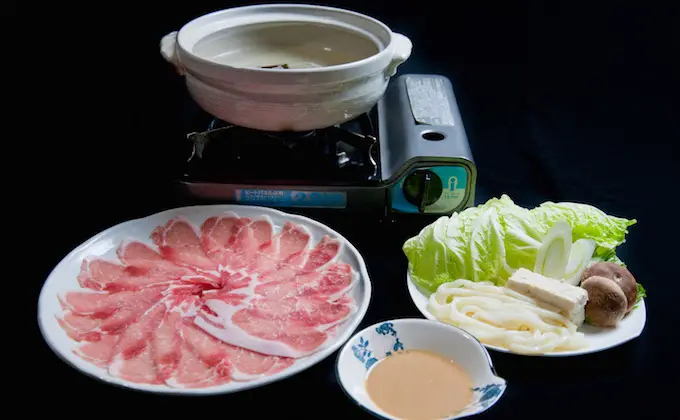
Shabu Shabu (Source: Google)
In Japan, shabu shabu first appeared in the early 20th century. The term “shabu shabu” actually comes from the sound the ingredients make when they are swished around in the boiling broth. The meal was influenced by “mutton shabu,” a similar Chinese hot pot that became popular in Japan during the Meiji period in the late nineteenth century.
In 1952, a Tokyo restaurant named “Suehiro” is often credited with introducing shabu shabu as we know it today. The owner, Shigetoshi Fujioka, wanted to create a new dining experience by serving high-quality beef that customers could cook themselves at their tables.
In Japan at the time, beef consumption was not very common due to post-war food shortages. However, Fujioka believed that by serving thinly sliced beef that cooks quickly, he could provide a delicious and affordable alternative to his customers. He named the dish “shabu shabu” to mimic the sound of the meat being cooked in the bubbling broth.
Shabu shabu is now a staple of Japanese cuisine and is typically associated with festive occasions and celebrations. To accommodate varied tastes, the meal has grown to include versions with various types of meat, fish, and vegetarian choices.
Hot Pot
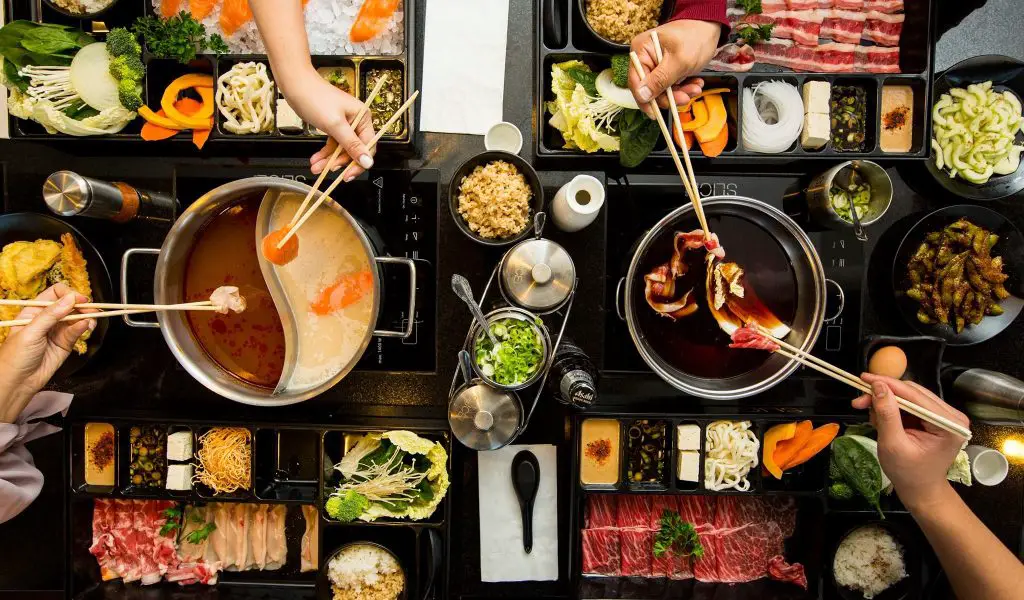
Hot Pot (Source: Google)
Hot pot, also known as Chinese fondue or steamboat, is a popular cooking method that originated in China. More than a thousand years ago, during the Tang Dynasty (618–907 AD), its history may be found.
The concept of communal cooking in a shared pot of boiling broth likely emerged as a practical solution for the cold winters in northern China. Hot pot provided warmth and nourishment and brought people together around a common meal. Over time, hot pot evolved into a cultural tradition enjoyed by families and friends throughout China and various parts of Asia.
Hot pot diversifies across different regions in China, leading to regional variations in flavor profiles and ingredients. For instance, in Guangdong province, mild-flavored broths and fresh seafood are often favored, while in Mongolia, lamb and mutton hot pot prevail.
In the 20th century, hot pot gained international recognition as Chinese communities began to migrate around the world. Hot pot is a popular dish today all over the world, and different versions of the cooking technique can be found in nations like Japan (shabu-shabu), Korea (jeongol), Thailand (suki), and Vietnam (lẩu).
You might be also like:
- Step into Tradition: Exploring the Fascinating World of Traditional Japanese Shoes
- Most Expensive Steak in Japan: Discover food in Japan
- Japanese Food Culture – A Culinary Adventure
Cooking Methods and Ingredients
Shabu-Shabu
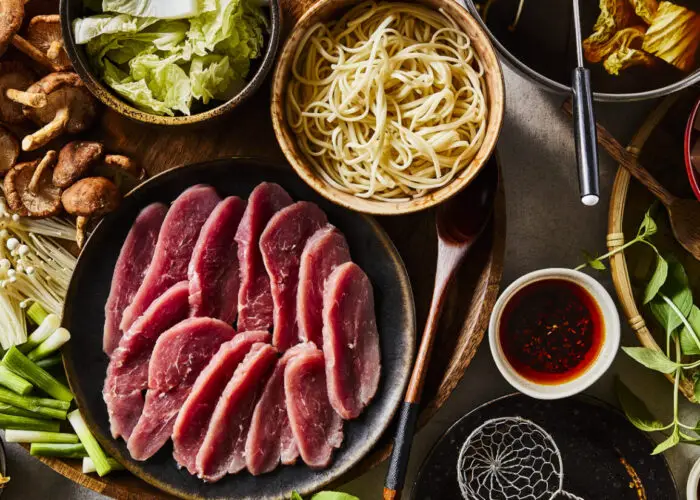
Shabu-Shabu (Source: Google)
- Prepare the broth: Making your own broth requires adding dried seaweed called kombu to a big saucepan of water and letting it soak for about 30 minutes. Then, slowly heat the pot until it reaches a gentle simmer. Remove the kombu just before it starts to boil. If using pre-made dashi or broth, heat it up in a separate pot.
- Set the table: Place a portable burner or electric hot pot in the center of the dining table. Surround it with plates of sliced meat, vegetables, and dipping sauces.
- Heat the broth: Bring the prepared or pre-made broth to a simmer in the heated pot. Adjust the heat to maintain a gentle simmer throughout the meal.
- Start cooking: Shabu-shabu is a method of cooking where each person takes a slice of beef and stirs it around in a boiling broth until it is barely done. Normally, this procedure takes a few seconds. Once cooked, dip the meat into your preferred dipping sauce.
- Add vegetables and other ingredients: These should be added to the saucepan after the meat has finished cooking. Cook them briefly until they reach the desired tenderness. Be careful not to overcook them.
- Enjoy: Retrieve the cooked food from the pot using chopsticks or a small strainer. Dip the cooked items into the dipping sauces and enjoy the flavorful combination of meat, veggies, and broth.
Hot Pot
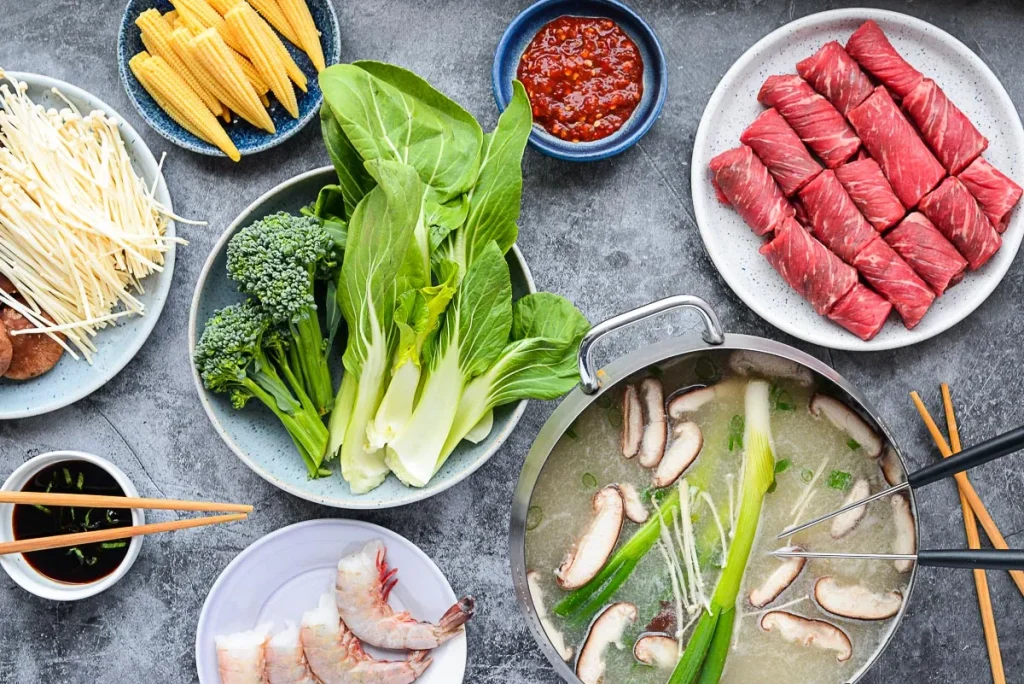
Hot Pot (Source: Google)
- Prepare the broth: Start by boiling water or stock in a pot. You can use store-bought soup bases or make your own by adding various flavorings like dried herbs, spices, vegetables, meat bones, or seafood.
- Set up the hot pot: Place the pot with the simmering broth in the center of the dining table. If you don’t have a specialized hot pot cooker, you can use a portable electric stove or even a fondue pot.
- Add ingredients to the broth: Once the broth is ready, you can begin adding ingredients. It is preferable to add ingredients gradually because the cooking times may vary based on the item.
- Cook the ingredients
- Enjoy: Use chopsticks or a slotted spoon to retrieve the cooked ingredients from the hot pot. Dip them into various sauces for added flavor. Soy sauce, sesame oil, garlic, chili oil, vinegar, and peanut sauce are typical dipping sauces.
Broth and Flavoring
Shabu-Shabu
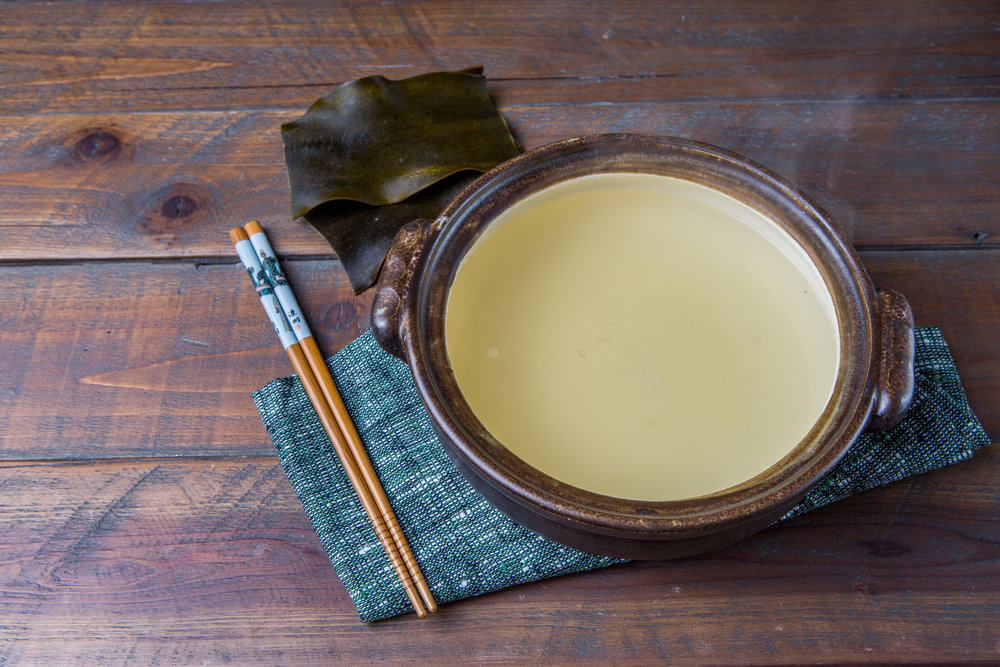
Vegetable Broth (Source: Google)
- Broth: Shabu-shabu broths often have a mild, delicate flavor that emphasizes the authentic flavor of the ingredients. The most common type of shabu-shabu broth has a kombu (seaweed) and/or dashi (fish stock) base. This creates a delicate and umami-rich broth that enhances the flavors of the ingredients without overpowering them.
- Flavoring: The dipping sauces are the main emphasis of shabu-shabu, rather than seasoning the broth itself. A variety of dipping sauces are frequently offered at the table so that customers can create their own taste combinations. Ponzu sauce, a soy sauce with a citrus base, sesame sauce, soy sauce with garlic and scallions, and hot chili oil are examples of common shabu-shabu dipping sauces.
Hot Pot
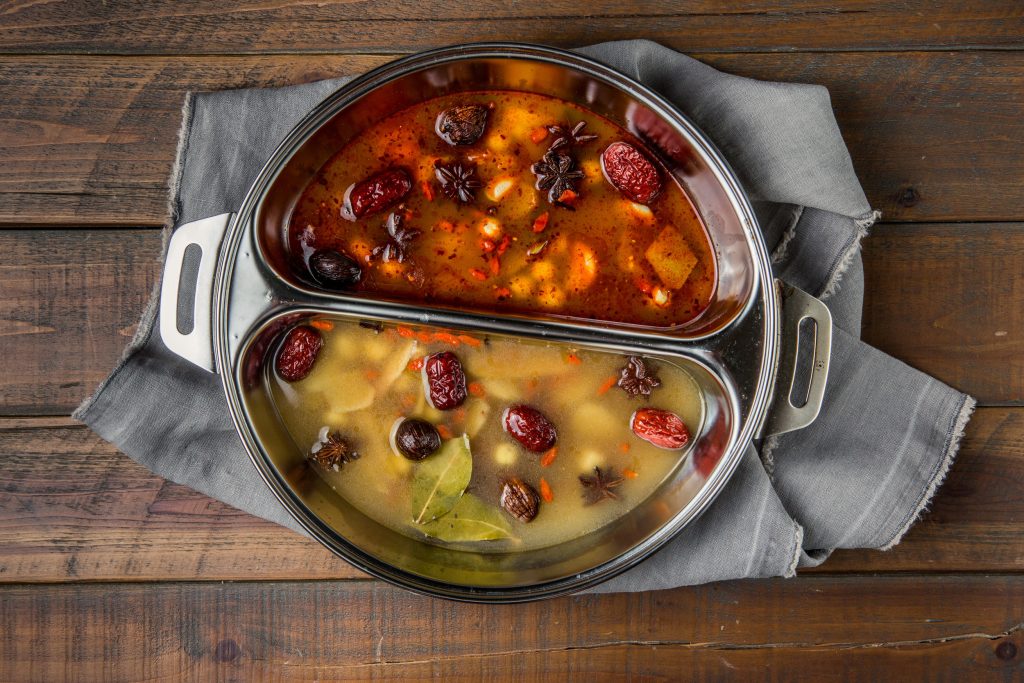
Hot Pot Broth (Source: Google)
- Broth: Hot pot broths come in a wide variety of flavors and styles, depending on regional preferences. Spicy Szechuan, clear vegetable, mushroom, seafood-based, or even bone broth are commonly used.
- The broths tend to be more robust and heavily seasoned, often featuring a combination of herbs, spices, and condiments. Ingredients like dried chiles, Szechuan peppercorns, ginger, garlic, star anise, and fermented bean pastes are used in some hot pot broths to provide rich and diverse tastes to the broth.
- Flavoring: In a hot pot, the broth itself is often the main source of flavor for the ingredients. As the ingredients cook in the flavorful broth, they absorb the essence and impart their own flavors. Additional sauces and condiments, on the other hand, can be applied to boost the flavor.
Serving Style
| Shabu- Shabu | Hot Pot | |
| Table Setup | A portable gas or electric burner, as well as a huge pot filled with savory broth, is put in the center of the dining table. The pot is divided into two sections to accommodate different broth flavors if desired. | A heating equipment, similar to shabu shabu, is put up in the center of the table, along with a pot of soup. The pot may be divided into sections to accommodate different broth flavors. |
| Diners’ Stations | Each diner is provided with an individual dipping sauce bowl and a small plate for condiments like garlic, scallions, and chili peppers. Chopsticks and a ladle are also provided. | Each diner has their own sauce dishes and condiment plate, along with utensils like chopsticks, spoons, and ladles. Additional serving utensils may be provided for communal ingredients. |
| Ingredients | The most frequent meat used in shabu shabu is thinly sliced beef (typically ribeye). Other protein options may include pork, chicken, or seafood like shrimp or scallops. Vegetables like Napa cabbage, leafy greens, mushrooms, tofu, and udon noodles are commonly included. | Meat options can include thinly sliced beef, lamb, pork, or even offal. Seafood like fish balls, shrimp, and squid are popular choices. Vegetables, mushrooms, tofu, noodles, and dumplings are also commonly included. |
| Cooking Process | Diners dip the raw ingredients into the simmering broth using chopsticks, swishing them back and forth until they are cooked to their desired doneness. The cooked ingredients are then dipped into individual bowls of sauce before being eaten. | Diners place the raw ingredients into the simmering broth using utensils, allowing them to cook until done. Once cooked, the ingredients are dipped into individual sauce bowls before being eaten. |
Cultural Significance and Dining Experience
Both shabu-shabu and hot pot offer interactive dining experiences that encourage socializing and sharing. They gather individuals around a table and let them prepare and personalize their meals to their liking. These dining experiences are also great for accommodating different dietary needs and preferences since individuals can choose the ingredients they prefer or avoid allergens or specific food items.
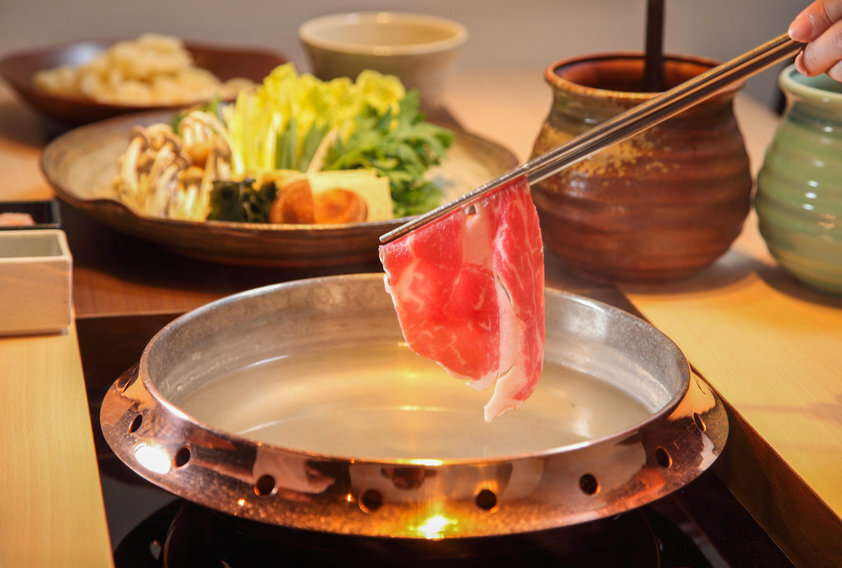
Shabu Shabu (Source: Google)
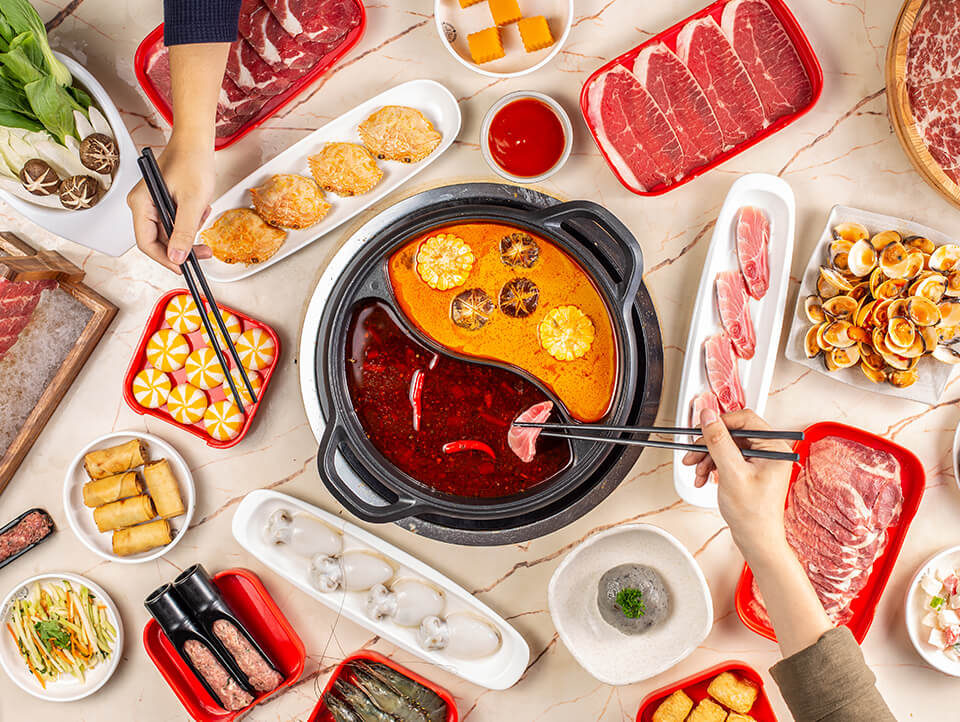
Hot Pot (Source: Google)
From a cultural standpoint, shabu-shabu and hot pot reflect the values of communal dining and the importance of fresh, high-quality ingredients in Asian cuisine. They provide an opportunity for friends and family to congregate, mingle, and converse over a leisurely dinner. These dining experiences are not only about food but also about creating lasting memories and connections.
Shabu-shabu and hot pot have gained appeal outside of Asia in recent years, and can now be found in many regions of the world. Restaurants specializing in these cuisines frequently provide a variety of broth varieties, ingredient selections, and dipping sauces to accommodate a variety of tastes and preferences. Whether you choose shabu-shabu or hot pot, both offer unique cultural significance and memorable dining experiences that are worth exploring and enjoying with others.
FAQs
1) What are some popular vegetarian or vegan options for those who want to enjoy shabu-shabu or hot pot without meat or seafood?
For those who prefer vegetarian or vegan options in shabu-shabu or hot pot, there are several delicious alternatives available. Here are some popular choices:
- Tofu: Firm tofu is a common ingredient in vegetarian shabu-shabu.
- Mushrooms: Mushrooms like shiitake, enoki, oyster, and king oyster mushrooms are delicious complements to vegetarian hot pot.
- Vegetables: Leafy greens like napa cabbage, bok choy, spinach, or watercress cook quickly and provide freshness to the meal.
- Noodles: Many types of noodles work well in hot pot dishes. Udon, glass noodles, or rice noodles are popular choices.
- Bean curd products: Vegetarian-friendly bean curd products like vegetarian dumplings, mock meatballs, or seitan (wheat gluten) can be added to enhance the variety and texture of the dish.
2) How does shabu-shabu differ from other types of hot pot?
Shabu-shabu is a sort of hot pot that originated in Japan and has unique qualities that distinguish it from other forms of hot pot. The ingredients are cooked very briefly, just until they are barely cooked through. This quick cooking method allows the ingredients to retain their freshness and tenderness.
Shabu-shabu is often enjoyed as an individual serving, where each person has their own personal pot or hot plate for cooking.
3) Are there any tips or tricks for creating a flavorful broth for shabu-shabu or hot pot?
- Utilize quality ingredients
- Long simmering time
- Adding bones or meat to the broth
- Adding seasonings and spices
- Dried seafood and mushrooms
- Skim off any foam, scum, or fat
4) Are there any regional variations or specific cultural customs associated with shabu-shabu or hot pot?
Korean Jeongol: In Korea, a similar concept called “jeongol” exists. Jeongol refers to a Korean-style hot pot that combines various ingredients like meat, seafood, vegetables, and noodles. Typically, the broth is flavored with gochujang, or soybean paste, giving it a distinct Korean flavor.
Thai Sukiyaki: In Thailand, a shabu-shabu version known as “sukiyaki” is popular. Thai sukiyaki is a meal with thinly sliced meat, seafood, noodles, veggies, and tofu cooked in a hot pot.
5) What are the main ingredients used in shabu-shabu and hot pot?
Shabu-shabu and hot pot are both popular Asian dishes known for their interactive and communal dining experiences. Here are some of the primary elements frequently used in shabu-shabu and hot pot; however, precise components may vary based on regional preferences and personal preferences: Broth, meat (chicken, cattle, lamb, and hog), seafood (clams, shrimp, and squid), vegetables, etc
6) Which cuisine or culture do Shabu Shabu and Hot Pot originate from?
Shabu Shabu and Hot Pot have their origins in East Asian cuisines. Japanese cuisine is known for its dish called shabu shabu, which originated in the 20th century. The term “Shabu Shabu” comes from the Japanese sound for swishing thinly sliced meat in boiling water or broth. However, Hot Pot is a culinary custom that has its roots in China and is well-known in several East Asian nations, including China, Taiwan, and Korea. It involves cooking a variety of ingredients, such as meats, vegetables, and seafood, in a simmering pot of flavored broth at the dining table.
7) What are the key similarities and differences between the broths used for Shabu Shabu and Hot Pot?
The broths used for Shabu Shabu and Hot Pot share some similarities but also have notable differences. In both cuisines, the broths serve as a base for cooking the ingredients. The broths are typically simmered with aromatics like ginger, garlic, and scallions to enhance the flavors. However, there are variations in flavors between Shabu Shabu and Hot Pot broths. Shabu Shabu broth is usually light and delicate, often made from kombu (seaweed) or bonito flakes, providing a subtly savory taste. On the other hand, Hot Pot broths tend to be more robust and can vary widely, ranging from spicy and numbing (Sichuan-style) to mild and herbal (Chinese herbal broth).
8) Which one is considered more traditional: Shabu Shabu or Hot Pot?
Both Shabu Shabu and Hot Pot have long histories and are deeply rooted in their respective cultures, making it difficult to determine which one is more traditional. In the 20th century, Shabu Shabu was invented in Japan. While it may not have as long a history as Hot Pot, its cultural significance and popularity in Japan make it a traditional Japanese dish. On the other hand, Hot Pot has ancient roots in China and has been enjoyed for centuries across various East Asian countries. Ultimately, both Shabu Shabu and Hot Pot hold cultural significance and can be considered traditional in their own right.
9) Do Shabu Shabu and Hot Pot have any specific health benefits?
Shabu Shabu and Hot Pot can offer some health benefits due to their cooking methods and ingredients. Both emphasize a wide variety of fresh vegetables, allowing for a nutrient-rich meal. The cooking process in boiling broth helps retain the natural flavors and nutrients of the ingredients. The broths frequently include herbs and spices as well, which may have potential health-promoting qualities. For instance, some Hot Pot broths include ingredients like ginger, garlic, and Chinese medicinal herbs known for their potential health benefits. However, it’s important to note that the overall healthiness of Shabu Shabu or Hot Pot depends on ingredient choices, portion sizes, and individual dietary needs.
10) What are some popular meat and vegetable choices for Shabu Shabu and Hot Pot?
For Shabu Shabu and Hot Pot, there is a wide range of popular meat and vegetable choices that can be enjoyed. Common meat options include thinly sliced beef, pork, chicken, and seafood like shrimp or sliced fish. Vegetables like Napa cabbage, spinach, mushrooms, tofu, and green onions are a good choice of the meal. The choice of ingredients can vary based on personal preferences and regional variations in Shabu Shabu and Hot Pot styles.
Conclusion
In conclusion, when it comes to the debate between Shabu Shabu and Hot Pot, both have their unique flavors and dining experiences to offer. Shabu Shabu, with its thinly sliced meat and emphasis on dipping in a flavorful broth, provides a more refined and delicate experience. On the other hand, Hot Pot offers a communal dining adventure with a wide range of ingredients cooked together in a bubbling pot of fragrant broth.
The choice between the two ultimately depends on personal preferences and the desired dining atmosphere. Whether you prefer the simplicity and elegance of Shabu Shabu or the conviviality and variety of Hot Pot, both options promise a satisfying and enjoyable meal for lovers of Asian cuisine.


